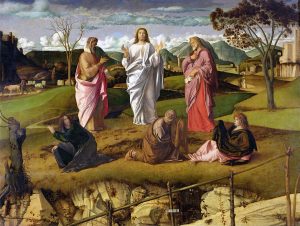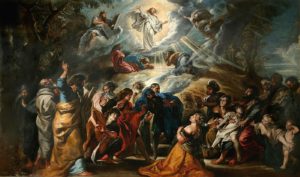First Reading: Exodus 34:29-35
Radiant light shines through Sunday’s readings for the Feast of the Transfiguration, and Moses appears in all four of them.

Transfiguration of Christ (c.1487), oil painting on panel by Giovanni Bellini (c.1430-1516).
National Museum of Capodimonte, Naples, Italy. (Click image to enlarge.)
Take a closer look, and find a consistent emphasis on God’s covenant with the people to follow God’s commandments to love God and our neighbors. In the first reading, we see Moses bringing the commandments down the mountain, his face transfigured in light by his encounter with the Holy One.
Psalm: Psalm 99
This mighty ancient hymn envisions God as a powerful king receiving loud chants of praise. In the temple in Jerusalem, images of two cherubim – scary angels depicted as lions with wings and human faces – were placed atop the Ark of the Covenant to serve as God’s throne. The Psalmist understands God as no petty tyrant but a mighty ruler who demands justice, holding the people to their covenant call to love their neighbors and care for the widow, the orphan and the stranger in our midst.
Second Reading: 2 Corinthians 3:12-4:2
In his second known letter to his congregation at Corinth, Paul recalls the Exodus story about Moses coming down the mountain with his face shining. Invoking the the image of the veil that Moses used to conceal his transcendent glow, Paul turns it around to express the idea that Jesus “unveils” God’s covenant in all its shining glory. For those who believer in Christ, Paul says, the veil is removed and they can see the image of God as if reflected in a mirror by the Holy Spirit. Be truthful, Paul urges the believers in Corinth. Do not hide behind a veil, but be steadfast and bold.
Gospel: Luke 9:28-36, [37-43a]
Jesus and his apostles Peter, John and James go up on the mountain to pray. Suddenly Elijah and Moses join him, and Jesus’ face and clothing shine in dazzling light. The three, the Gospel says, were talking about Jesus’ departure (or exodus in the perhaps significant Greek original), which he was about to accomplish at Jerusalem. Then a cloud forms around them and God’s voice is heard, repeating the words that God spoke from a cloud at Jesus’ baptism in the Gospel for the first Sunday of Epiphany: “This is my Son, my Chosen; listen to him!” Jesus and the terrified apostles come down from mountain, and life returns to what is normal for Jesus: He astounds the crowd by casting out a child’s angry demon.



